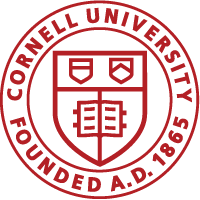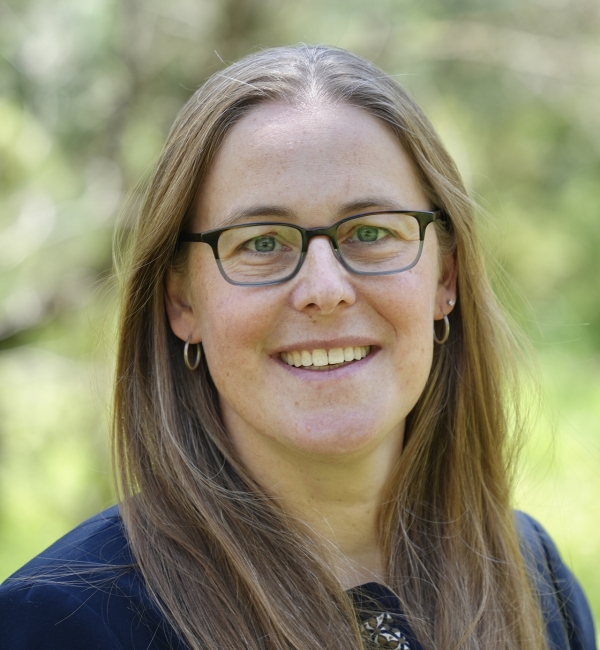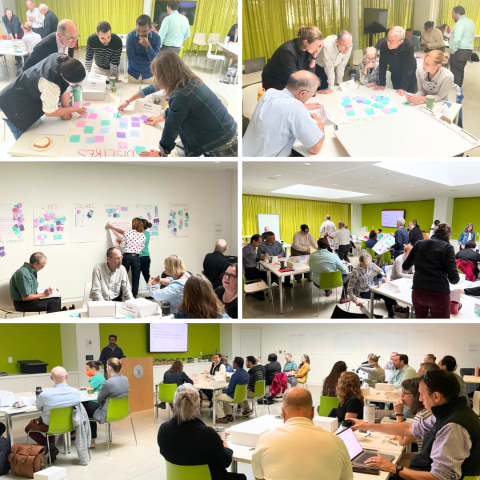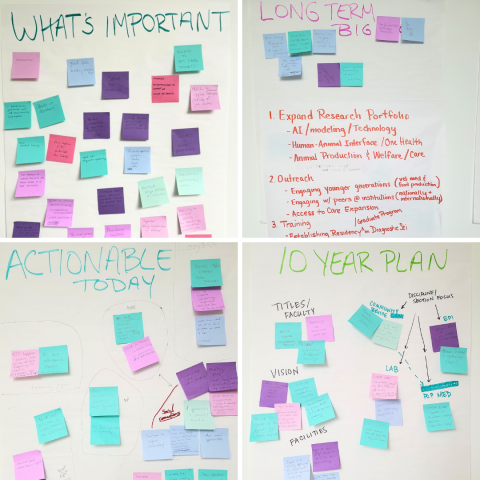Strategic Plan 2025-2030
Mission
To advance animal health and welfare through innovative disease diagnosis and prevention, ensure the safety of animal-derived foods, educate the next generation of veterinary professionals, and serve the public good by providing expert clinical, diagnostic, and outreach services to the residents of New York and beyond.
Vision
We will enhance the health, welfare, and productivity of all animal populations—from livestock to companion animals and wildlife—by leveraging our expertise in population dynamics of health and disease, providing state-of-the-art diagnostic services, engaging in science-based outreach efforts, and addressing emerging challenges in the veterinary profession.
“Our People Are Our Strength”
Letter from the Chair
When I first joined the Department of Population Medicine and Diagnostic Sciences in 2014, I was struck by the vast array of species and diseases my colleagues investigated. It remains a strength of the department to this day: We touch every instructional block in the veterinary curriculum and teach a wide range of domestic and wildlife species, with some faculty being the sole experts on certain species in the College of Veterinary Medicine. Our breadth and depth are astounding.
As a research powerhouse, we expand our profession’s understanding of population health and existing and emerging diseases. Our investigations range from disease dynamics in animal populations to developing new laboratory-based diagnostic tests, bolstering science-based veterinary and public education, and advancing the field’s understanding and application of veterinary economics.
Our mission includes using our expertise for the public good through teaching and outreach services. We educate students, graduates, the public, and professionals in the animal industry. Veterinary students gain small animal population medicine and surgery experience and first-hand practitioner knowledge through our agricultural animal teaching practice. Our trainees learn the principles of disease diagnosis and management, and the dynamics of infection in animal populations. The next generation of researchers, practitioners, and public health workers come through our department’s doors. Moreover, our faculty present research, share best practices, and collaborate with other professionals at conferences and symposiums. Their outreach efforts touch the work of industry professionals, state, national, and international stakeholders, as well as the everyday lives of animal owners.
As part of a land-grant institution, we utilize state-of-the-art laboratory diagnostics for veterinarians and animal owners within New York and beyond. We promote the production of safe, high-quality foods and create and implement science-based protocols for population-level health. Consequently, few departments can as confidently say their influence spans local, regional, state, national, and international communities, and we will build on this legacy of impact through this strategic plan.
A common theme from our strategic planning process was: “Our people are our strength.” It isn’t just the theme of this document, but the reality of our department. It is a privilege to work among so many bright, driven, and creative colleagues, who together foster an inclusive environment that encourages exploration.
Our strategic planning process began in the fall of 2024 with an in-person, half-day retreat to discuss our strengths, areas for improvement, and future aspirations. This was followed by an online survey and early drafts of the strategic plan.
Three priority areas emerged:
- Support a Productive Department Climate
- Provide Trusted Instruction and Outreach
- Advance Infrastructure and Technological Development
Given Cornell’s financial situation and our recent budget cutbacks, we need to think creatively about achieving our goals. With the lasting impact of COVID-19, changes in generational learning, and shifting lab and office space due to renovations, hiring or expansion will likely be restricted for several years. We must brainstorm ways to move forward productively. Our planning has given us a healthy start and aligns with several of the College of Veterinary Medicine’s strategic initiatives including building a community-minded culture, advancing clinical and diagnostic expertise, and applying new technology. This plan is both practical and aspirational, and I’m excited to follow it with you.
Thank you for your thoughtful participation in this process. Together, we are taking steps to keep the Department of Population Medicine and Diagnostic Sciences a place of fruitful scholarship and service, helping it grow to meet future needs and goals.
Respectfully,
Jessica McArt, DVM, PhD, DABVP (Dairy Practice)
Professor & Chair
Department of Population Medicine & Diagnostic Sciences
State of the Department
Faculty Over Time
| Fiscal Year | 2017 | 2018 | 2019 | 2020 | 2021* | 2022 | 2023+ | 2024 | 2025§ |
|---|---|---|---|---|---|---|---|---|---|
| TT Faculty** | 17 | 18 | 19 | 18 | 20 | 17 | 18 | 18 | 29 |
| RTE Faculty++ | 40 | 43 | 42 | 40 | 38 | 29 | 37 | 40 | 39 |
| Total | 57 | 61 | 61 | 58 | 58 | 46 | 55 | 58 | 68 |
* Public and Ecosystem Health faculty depart
+ Anatomic Pathology faculty join
§ Projected
** Tenure track faculty
++ Research, teaching, extension faculty
Faculty Demographics
Faculty with primary appointments in the Department of Population Medicine and Diagnostic Sciences. Data current as of February 2025.
| Role | TT Faculty | RTE Faculty |
|---|---|---|
| Female | 10 | 26 |
| Male | 20 | 13 |
| Total | 30 | 39 |
Trainees Over Time
| Academic Year | 2016-2017 | 2017-2018 | 2018-2019 | 2019-2020 | 2020-2021 | 2021-2022 | 2022-2023 | 2023-2024* | 2024-2025 |
|---|---|---|---|---|---|---|---|---|---|
| Intern | 2 | 3 | 4 | 4 | 4 | 3 | 3 | 3 | 4 |
| Resident | 5 | 4 | 4 | 4 | 3 | 3 | 11 | 13 | 13 |
| Post Doc | 20 | 15 | 12 | 19 | 21 | 16 | 18 | 14 | 22 |
| Grad Student | 10 | 14 | 16 | 18 | 16 | 18 | 16 | 17 | 15 |
| Total | 37 | 36 | 36 | 45 | 44 | 40 | 48 | 47 | 54 |
* Anatomic Pathology faculty join January 2023
Grants and Contracts
Data current as of February 2025.
| Fiscal Year | 2020 | 2021 | 2022 | 2023 | 2024 | 2025* |
|---|---|---|---|---|---|---|
| Grants Submitted | 144 | 73 | 68 | 72 | 103 | 63 |
| Grants Awarded | 58 | 38 | 39 | 39 | 47 | 6 |
| Amount Awarded | $14,178,587 | $8,901,372 | $5,573,689 | $4,961,122 | $6,702,757 | $1,481,358 |
* In progress
Staff
Administrative support includes full- and part-time staff, with time split between the AHDC and PMDS. Data current as of February 2025.
- Director of Operations and Business
- Administrative Assistant to the Chair and AHDC Director
- Administrative Assistant
- Equipment Technologist
- Finance Specialist
- Research Administrative Coordinator
- Research Administrative Coordinator
- Part-time Research Administrative Coordinator
Priority Area 1
Support a Productive Department Climate
Over the next five years, we must protect and advance our department culture. This includes our ability to collaborate, how we interact with each other, the availability of support and resources, the freedom to pursue diverse research specialties, and respect for our responsibilities and passions outside of work.
We will prioritize faculty career development, encouraging growth and identifying opportunities for professional development. Our mentorship programs will help junior faculty navigate obstacles and create leadership pathways for seasoned faculty. On a higher level, we will work with human resources to support an inclusive and equitable environment, brainstorm creative recruitment tactics, and support diverse faculty strengths and goals. Events like grant-writing workshops, informal talks, new faculty lunches, open houses, social events, and retreats will augment teaching and research responsibilities and check our strategic plan progress.
Smaller-scale actions can greatly impact department satisfaction, such as keeping meeting agendas and outcomes achievable and codifying work-life blend expectations. As a department, we will continue to petition college and relevant university groups to address work needs, such as installing convenient bike racks and increasing childcare options for faculty and staff. We will build into our workplace process the room for people to represent our interests during the creation and implementation of solutions. These small actions will go a long way in both recruiting and retaining valued members of our department.
Next Steps
- Establish regular social gatherings and early-career faculty luncheons
- Create workgroup to discuss potential associate chair positions or other new roles to allow interested faculty to increase their administrative acumen
- Send a letter of support to our administration about work-life blend, childcare concerns, and well-being initiatives like bike racks
Priority Area 2
Provide Trusted Instruction and Outreach
Cornell’s land-grant mission mandates us to use our expertise for the betterment of farmers, shelters, veterinarians, the public, wildlife conservationists, and ultimately national and international organizations and people. We will continue to achieve this by upholding our research specialties, engaging outside of the college, and providing trusted instruction.
To provide trusted instruction, we must be at the forefront of investigation, and research is vital to our department’s academic health. We will maintain existing research areas and add new topics based on future needs, such as shelter medicine, epidemiology, and bioinformatics. We aim to expand our research portfolio by evolving our own specialties and by recruiting faculty with unique expertise. This will require collaboration and coordination with other departments and units and support from the College of Veterinary Medicine, both materially and culturally. We will work together with colleagues across the college to identify facilities, equipment and core resources to conduct our work.
Our outreach services will continue to impact communities like New York farms and shelters, evolving to improve and expand our reach. Extension will remain a pillar of the department. Moreover, we will strengthen key resources that support the New York dairy industry, like reviving the Dairy Center of Excellence, and investigate ways to increase grant and donation opportunities for Maddie’s® Shelter Medicine Program.
At every opportunity, we will leverage our knowledge to become the go-to for animal health information, whether through peer-reviewed publications, conference speaking engagements, or public seminars. Over the next five years, we will expand outreach activities to engage younger generations, attract new partners, and increase collaborations between national and international institutions. Combined, these efforts will bolster our service to the public and ensure we remain a valuable resource for years to come.
Devoted time to teaching in the veterinary curriculum is one of our key goals. We commit to providing valuable, intentional instruction to prepare students to serve animal populations, big and small. We will create a workgroup to assess teaching efforts and identify ways to provide stronger support systems for our faculty. The workgroup will quantify teaching effort and capacity, with the intention of accurately describing faculty efforts and outlining a sustainable, long-term protocol that ensures adequate time for preparation and instruction.
Most importantly, we will continue to respect each other’s personal interests and contributions based on their efforts, including service, outreach, teaching, and research. Our department is collaborative in nature, which gives us the opportunity to pursue many interests, something we will preserve and protect over the next five years. Diversity in the department, in all respects, remains fundamental.
Next Steps
- Create a teaching-focused workgroup on instructional efforts and expectations
- Restore the Dairy Center of Excellence
- Establish monthly seminars, followed by social event
Priority Area 3
Advance Infrastructure and Technological Development
Vibrant research in population medicine and diagnostic sciences requires sufficient space, infrastructure, and technological progress.
To counter existing budget limitations, we will evaluate and optimize our current spaces, encouraging collaboration and cooperation regarding technology and location. Moreover, during the planning process for the Animal Health Diagnostic Center building expansion, we will advocate that the facility design optimizes our department goals. We envision grouping faculty in area-specific spaces, fostering collaboration and creativity.
The technological landscape is constantly evolving, and we will stay abreast of technological advancements, such as artificial intelligence, to remain on the cutting edge. To lead the field, we will continue to develop, use, and adapt technology that advances our work.
In additional to physical space, we intend to increase our interaction with college entities like the Center for Veterinary Business and Entrepreneurship, the Cornell University Hospital for Animals, and the Animal Health Diagnostic Center. Strengthening this network will diversify our offerings and enhance our scholarship. Connections with other groups first require us to shore up connections among the department. We will initiate section-specific planning meetings to identify group vision and collaborative opportunities and organize retreats with both social and professional goals. This people-focused infrastructure will enable us to identify other opportunities—such as when and where to hire additional support staff and needs for technical support from VMIT—providing us with future direction for the department.
Next Steps
- Evaluate existing spaces and how we use them
- Initiate section-specific planning meetings
- Determine where additional VMIT, equipment, and infrastructure support is needed
Strategic Plan Steering Committee
Should you have questions about this strategic plan or would like to discuss its contents, please reach out to us.
Dr. Jess McArt
Professor, Chair
jmcart@cornell.edu
Rocky Kambo
Director of Operations and Business
kambo@cornell.edu
Cristina Carter
Assistant to the Chair & Executive Director of the Animal Health Diagnostic Center
cmc452@cornell.edu
Dr. Melanie Greaver Cordova
Director of Communications and Client Relations
mc2647@cornell.edu






